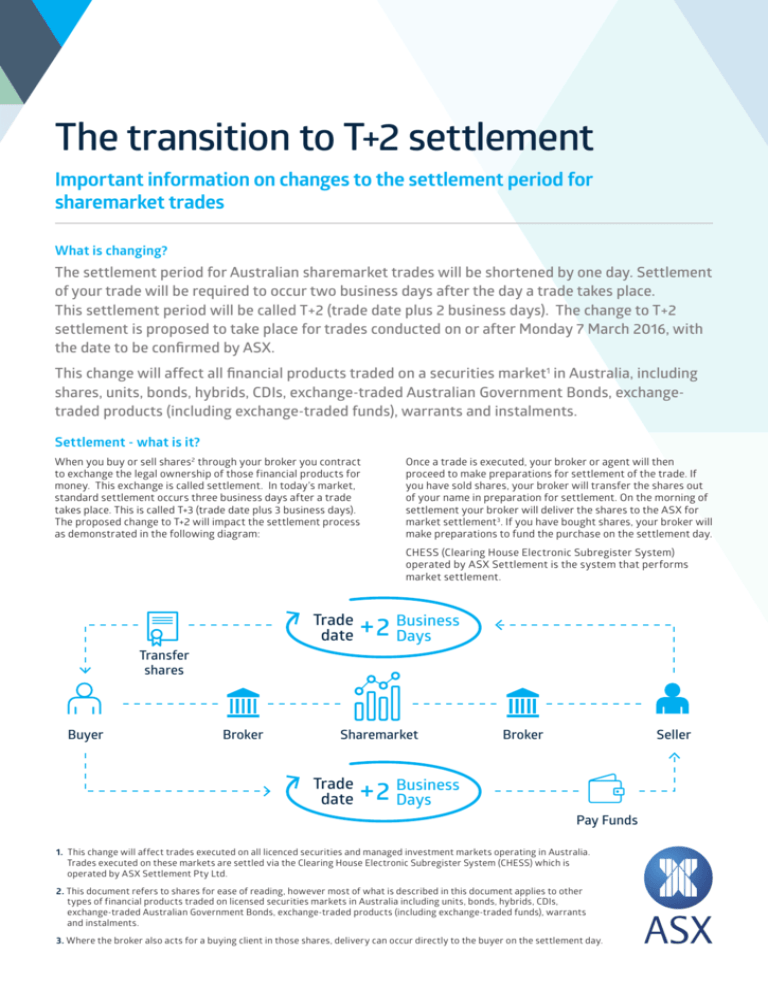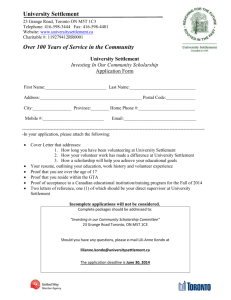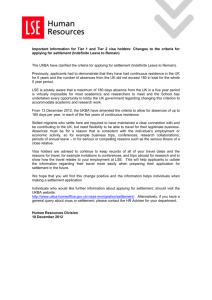
The transition to T+2 settlement
Important information on changes to the settlement period for
sharemarket trades
What is changing?
The settlement period for Australian sharemarket trades will be shortened by one day. Settlement
of your trade will be required to occur two business days after the day a trade takes place.
This settlement period will be called T+2 (trade date plus 2 business days). The change to T+2
settlement is proposed to take place for trades conducted on or after Monday 7 March 2016, with
the date to be confirmed by ASX.
This change will affect all financial products traded on a securities market1 in Australia, including
shares, units, bonds, hybrids, CDIs, exchange-traded Australian Government Bonds, exchangetraded products (including exchange-traded funds), warrants and instalments.
Settlement - what is it?
When you buy or sell shares2 through your broker you contract
to exchange the legal ownership of those financial products for
money. This exchange is called settlement. In today’s market,
standard settlement occurs three business days after a trade
takes place. This is called T+3 (trade date plus 3 business days).
The proposed change to T+2 will impact the settlement process
as demonstrated in the following diagram:
Once a trade is executed, your broker or agent will then
proceed to make preparations for settlement of the trade. If
you have sold shares, your broker will transfer the shares out
of your name in preparation for settlement. On the morning of
settlement your broker will deliver the shares to the ASX for
market settlement 3. If you have bought shares, your broker will
make preparations to fund the purchase on the settlement day.
CHESS (Clearing House Electronic Subregister System)
operated by ASX Settlement is the system that performs
market settlement.
Trade
date
+
Business
Days
Transfer
shares
Buyer
Broker
Sharemarket
Trade
date
+
Broker
Seller
Business
Days
Pay Funds
1. This change will affect trades executed on all licenced securities and managed investment markets operating in Australia.
Trades executed on these markets are settled via the Clearing House Electronic Subregister System (CHESS) which is
operated by ASX Settlement Pty Ltd.
2. This document refers to shares for ease of reading, however most of what is described in this document applies to other
types of financial products traded on licensed securities markets in Australia including units, bonds, hybrids, CDIs,
exchange-traded Australian Government Bonds, exchange-traded products (including exchange-traded funds), warrants
and instalments.
3. Where the broker also acts for a buying client in those shares, delivery can occur directly to the buyer on the settlement day.
Why the change?
Your arrangements with your broker
Faster settlement means quicker access to your money after
selling your shares and earlier delivery after purchasing shares.
Since 1992 ASX has improved the settlement cycle, from T+5
to T+3 in 1999 and soon to T+2. This keeps our market globally
competitive, reduces risk and improves efficiencies in the
securities market.
A little bit of housekeeping goes a long way to making
settlement of your share trades efficient. T+2 means one less
day for both parties of the trade to be ready to provide either
shares or cash to settle the trade.
Some tips to help make things as smooth as possible:
• Have an established relationship with a broker, ideally with
How will this change impact corporate actions4
such as dividends?
CHESS holdings7 - CHESS holdings are easier for you and your
broker to keep track of
• Keep your holding details handy – have your HIN or SRN
In conjunction with the shortening of the settlement period
to 2 business days, it is also proposed by ASX to reduce the
period between two important dates for corporate actions –
the ex date5 and the record date6.
8
hand when contacting your broker
on
• Ask your broker to send contract notes electronically confirmations by mail should be avoided
• Fund your share purchases efficiently - your broker may get in
When the settlement period becomes T+2, the ex period for
corporate actions will be reduced from 3 business days to 2
business days (inclusive of the ex date and the record date).
Using dividends as an example, this means that if you buy shares
before the ex date you will receive the dividend. If you buy
shares on or after the ex date you will not receive the dividend.
touch with you to set out the range of funding arrangements
they will support under T+2. For example, the use of cheques
for payment may no longer be viable, as the length of time
required to clear the funds may exceed the settlement period.
Your broker may suggest the use of electronic funds transfer
(EFT) or direct debit, BPay or a cash management account.
Your broker may also require an earlier deadline for the funds
to be paid. It is important for you to work with your broker
to agree the best funding arrangements that will ensure
settlement occurs on time and therefore reduce any potential
failed settlement costs.
Sample process for a share purchase on the day before the ex-dividend date compared to the corporate action timeline
Trade
Buy shares
"cum"
dividend
Mon
Corporate
action
Trade
Tue
+
Settle "cum"
dividend
purchase
days
Wed
Ex-dividend
date
Thu
days
inclusive
Record
date
Advised
by Co
Payment
date
Need more information?
If you have any questions about these changes, please speak to your broker or agent.
You can also contact ASX customer service by phone: 131 279
4. Corporate actions include dividends, rights issues, bonus offers etc.
5. The ex date is the date on which shares change from being quoted “cum” (or entitled) to “ex” (or not entitled) for a corporate action.
6. The record date is the date used in determining who is entitled to a dividend or other entitlement associated with a share. Those on the register on
the record date are eligible for the entitlement.
7. A CHESS holding can be sponsored by a broker (may be referred to as “broker sponsored”) or certain other participants in the settlement facility
provided by ASX Settlement Pty Ltd other than brokers, and are identified with a Holder Identification Number (HIN).
8. SRN is a Securityholder Reference Number - it references a holding held on the issuer sponsored subregister.
Disclaimer:
This document provides general information only and may be subject to change at any time without notice. ASX Limited
(ABN 98 008 624 691) and its related bodies corporate (“ASX”) makes no representation or warranty with respect to the
accuracy, reliability or completeness of this information. To the extent permitted by law, ASX and its employees, officers and
contractors shall not be liable for any loss or damage arising in any way, including by way of negligence, from or in connection
with any information provided or omitted, or from anyone acting or refraining to act in reliance on this information. The
information in this document is not a substitute for any relevant operating rules, and in the event of any inconsistency
between this document and the operating rules, the operating rules prevail to the extent of the inconsistency.
© Copyright 2015 ASX Operations Pty Limited ABN 42 004 523 782. All rights reserved 2015.







